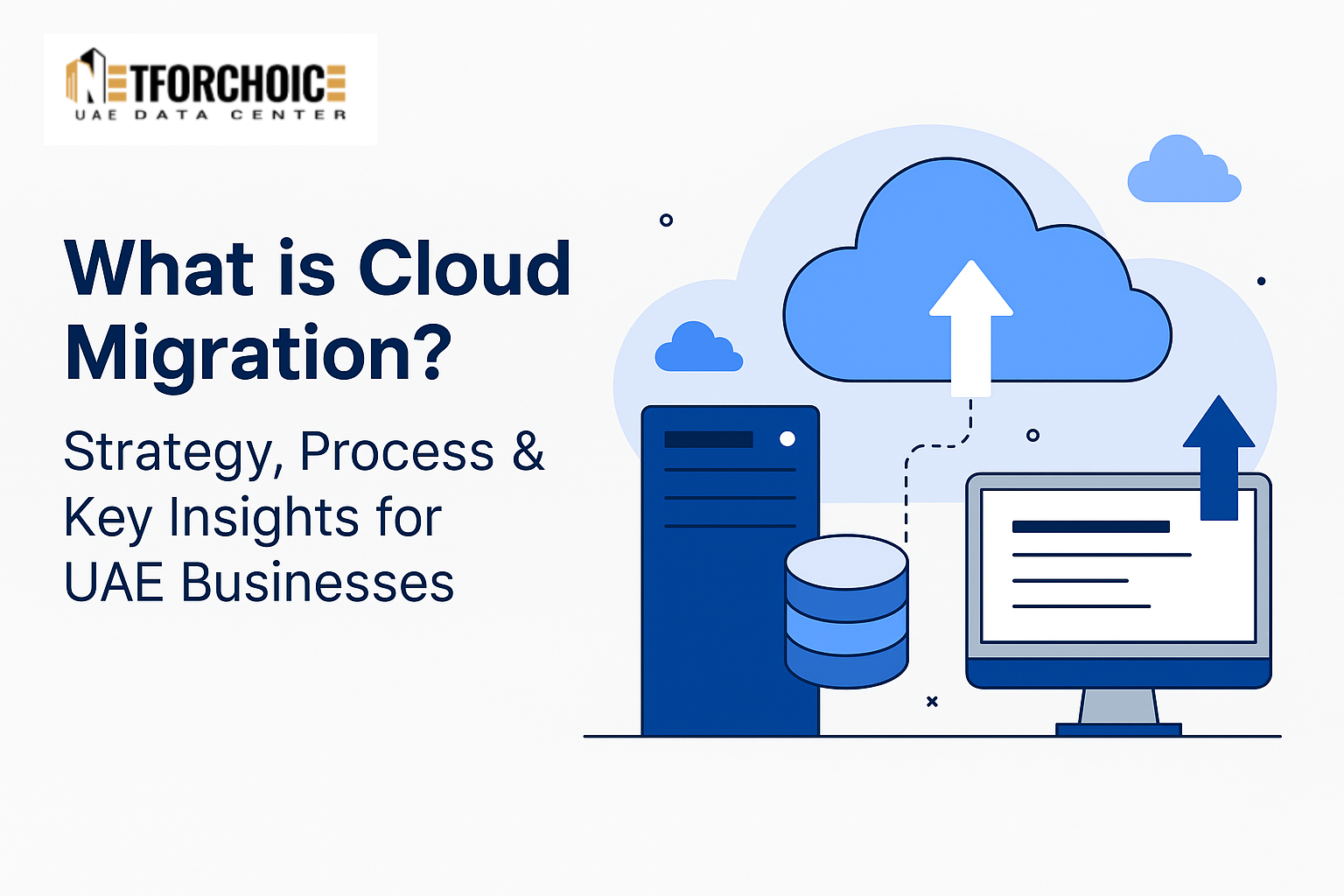What is Cloud Migration? Strategy, Process

Cloud Migration Essential Insights to UAE Businesses
Cloud migration refers to the act of transferring applications and data between one place, usually the on-premises, privately owned servers of a company, to a server of a public cloud provider, but it can also involve the transfer of resources between clouds. The advantages of cloud migration are cost savings in IT and enhanced performance, security, and convenience.
This blog will discuss the meaning of cloud migration, its types, service models, migration strategies, advantages, and challenges, as well as how NetForChoice can help in your digital transformation.
What is Cloud Migration?
Cloud migration refers to the act of transferring digital resources such as data, workloads, applications, and IT resources, on-premise infrastructure or another cloud platform to a public, private, or hybrid cloud.
Most commonly, UAE enterprises migrate from traditional data centers to scalable and secure platforms that offer the benefits of cloud hosting UAE, helping them meet performance and regulatory demands.
Types of Cloud Migration Services
In order to plan a successful cloud migration, it is necessary to know the different types of migration strategies. One or more of these types of migration may be most appropriate depending on the infrastructure of your organization, its compliance requirements and business objectives. The following are the four most important types of cloud migration services that businesses in the UAE usually look into:
1. Datacenter Migration
Datacenter migration is the process of relocating IT assets, such as servers, applications, databases, and storage, off-premise data centers to a cloud hosting UAE environment. Such migration is usually the initial step in the transition of organizations to a scalable pay-as-you-go cloud architecture, which replaces the traditional infrastructure.
Key Characteristics:
- Frequently incorporates physical-to-cloud (P2C) migration.
- Transfers large amounts of data using high-bandwidth internet or data box appliances.
- Provides business continuity and disaster recovery.
- It is perfect in instances where a company has to deal with hardware end-of-life or high maintenance costs.
At NetForChoice, we provide Tier IV compliant cloud infrastructure that ensures safe and effective datacenter migration according to the needs of the UAE enterprises.
2. Hybrid Cloud Migration
A hybrid migration is a combination of on-premises systems and cloud environments, which enables a business to migrate some of its workloads to the cloud, and keep others on-premises.
What is the point of Hybrid Cloud?
Complies with regulatory compliance and data residency regulations prevalent in sectors such as BFSI, government, and healthcare within the UAE.
- Allows gradual migration instead of a big-bang approach.
- Enables cloud-to-cloud backup and failover scenarios.
- Ideal for businesses with legacy systems that cannot be migrated immediately.
Hybrid environments give you the flexibility to manage critical workloads in your own infrastructure while utilizing cloud hosting UAE resources for scalability, DR, and business agility.
3. Cloud-to-Cloud Migration
This type of cloud migration refers to transferring data, workloads, or services from one cloud provider to another. As organizations grow, merge, or reassess their cloud strategies, they may opt to move from one public cloud (e.g., AWS) to another (e.g., NetForChoice Cloud).
Use Cases:
- Avoiding vendor lock-in or reducing cloud service costs.
- Access to better performance, features, or data locality (like UAE-based hosting).
- Consolidating resources from multiple providers into a centralized management platform.
- Seamless backup and replication between multi-cloud environments.
NetForChoice UAE helps clients orchestrate smooth cloud-to-cloud migrations services with zero data loss and minimal downtime.
4. Application, Database, and Mainframe Migration
This migration involves moving specific applications or databases like SQL Server, Oracle, SAP, Linux, or Windows-based workloads to the cloud. It can be executed in two major ways:
Lift-and-Shift (Rehosting): Moving applications to the cloud without changing their core architecture.
Refactoring: Modifying the app for better performance, scalability, and integration with cloud-native services.
Ideal For:
- Businesses needing faster compute power and high availability.
- Companies looking to reduce license and hardware costs.
- Organizations aiming to modernize legacy applications and utilize cloud-based development environments.
Whether it’s migrating a standalone CRM system or an entire ERP database, NetForChoice ensures secure, scalable, and compliant migration of mission-critical workloads.
Which Cloud Migration Strategy is Right for You?
Each cloud migration strategy serves a unique business need. Choosing the right one depends on factors like:
- Data sensitivity and compliance requirements
- Existing infrastructure investments
- Performance and latency expectations
- Budget and IT maturity level
Whether you’re considering a full datacenter move, hybrid migration, or a cloud-to-cloud switch, NetForChoice UAE provides end-to-end cloud migration solutions customized for your enterprise.
Talk to Our Migration Expert Now
Managed Service Models
| Model | Description | Use Case |
|---|---|---|
| IaaS | Infrastructure as a Service – virtual machines, storage, networking. | Full control over OS, ideal for developers and sys admins. |
| PaaS | Platform as a Service – includes OS, databases, runtime environments | Faster app development, less management required. |
| SaaS | Software as a Service – apps accessible via the internet | Email, CRM, document management tools. |
The 6 Stages of Cloud Migration Strategy:
- Define Strategy: Determine business objectives, budget, regulatory requirements and desired results.
- Plan: Choose workloads to migrate, dependency map and risk assessment.
- Ready: Make ready your cloud environment and current infrastructure.
- Migrate: Transfer workloads by means of secured and optimized transfer.
- Govern: Implement security, performance, and cost-monitoring policies.
- Manage: Keep cloud infrastructure best practice and monitoring.
Cloud migration Services UAE empowers businesses with on-demand scalability, allowing them to adapt to changing workloads without capital-intensive hardware upgrades.
Cloud Migration Benefits:
| Benefit | Description |
|---|---|
| Cost Efficiency | Reduce hardware, electricity, cooling, and real estate expenses. |
| Scalability | Easily scale resources based on demand—no overprovisioning. |
| Security | Built-in cloud security, encryption, and compliance support. |
| Disaster Recovery | Cloud backups and geo-redundancy for failover and continuity. |
| Centralized Management | Manage multiple workloads from a single cloud dashboard. |
Cloud migration UAE empowers businesses with on-demand scalability, allowing them to adapt to changing workloads without capital-intensive hardware upgrades.
Common Cloud Migration Challenges
- Planning complexity across large systems and teams.
- First costs in equipment and skills.
- Security & compliance settings gaps.
- Migration risk of downtime.
- Internal adoption barriers and staff training.
- Selecting the appropriate migration partner.
The Way NetForChoice Benefits Businesses in UAE
NetForChoice UAE is aware of the special regulatory, performance, and compliance requirements of gulf region businesses.
This is how we can assist you in cloud migration:
- Ultra-reliability Tier IV Data Centers in Dubai
- Full resilience using Cloud Backup & DRaaS
- Hybrid Email & Cloud Hosting UAE Solutions to be flexible
- Managed Migration Services- Planning to post deployment
- BFSI, Government, and Healthcare-ready Compliance-Ready Infrastructure
Final Thoughts
Cloud migration is not a technology improvement; it is a business enabler. UAE businesses can increase agility, reduce costs, and attain long-term digital resilience with the right strategy, the right service model, and the right partner such as NetForChoice.
Schedule Your Free Migration Consultation
FAQs
Q1. How long does cloud migration take?
It depends on your workload size and complexity. Small migrations may take days, while enterprise-level moves can take weeks or months.
Q2. Can I migrate only a few services and not the entire infrastructure?
Yes. Hybrid cloud migration is perfect for partial migration strategies.
Q3. What security features do cloud providers offer?
Encryption, identity access management, compliance certifications, firewall, and intrusion detection systems.
Q4. Will there be downtime during migration?
With careful planning and migration tools, downtime can be minimized or avoided completely.
